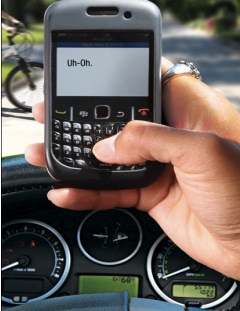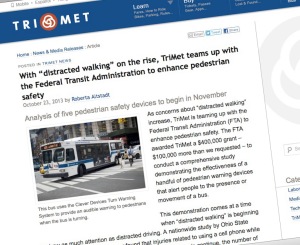
One of the things I spend time on everyday is monitoring headlines. I liken this part of my job to a military intelligence officer listening to “chatter” from satellites and other broadcast signals. It’s fascinating to watch various memes and issues go from a tiny whisper to a roar in a matter of hours. Another thing I try to watch for is how the same issue is spun in different ways.
In the past day or so, distracted driving has been on my mind (it actually never leaves my mind) and I’ve noticed several interesting headlines about it. Then this morning, a major regional transit agency put out a message about “distracted walking”. With all this chatter, I figured it was time to talk about this issue again.
In his most recent column titled, How do we curb our careless obsession with cell phones in cars? Oregonian columnist Steve Duin made it clear that he is concerned about this dangerous epidemic. In his piece, Duin points to the toothless penalties the currently exist in Oregon law for people caught using phones while driving. He also points out the vast gap in severity of punishment between drunk driving and distracted driving, event though it could be argued that, “the latter is far more hazardous to your judgment and reaction times”. Not only that, I’d add, but unfortunately distracted driving is far more common and socially accepted than drunk driving.
Duin’s column is good and I’m glad he’s concerned about this issue. As he points out though, enforcement and “tougher” laws isn’t making much of a dent in this dangerous activity. We need a change in culture where respect for the safety of other people is greater than the selfish habit of checking a phone when attention should be kept on the road. And since culture change takes so long, we can only hope that new technology helps the problem and that cities and states get serious about creating more physically protected bike lanes.
Speaking of infrastructure and creating more urgency from politicians and bureaucrats, Streetsblog analyzed new research that shows people walking and biking are getting hurt and killed at increasing rates due to distracted driving. Here’s an excerpt:
Pedestrian deaths attributable to distracted driving rose from 344 in 2005 to 500 in 2010, significantly faster than overall population growth. Annual bicyclist deaths caused by distracted driving rose from 56 to 73 over the same period. Together pedestrians and bicyclists accounted for about one in 10 traffic fatalities that resulted from distracted driving, researchers found.
Those stats, combined with the obvious reality that can be seen on the roads every day, should be all that elected officials need to prioritize this issue.
The Streetsblog story also quoted one of the study’s authors who said, “Evidence suggests that separating non-motorized travel from motorized travel, through bike lanes or other redevelopment efforts, could greatly reduce deaths.” Reading that, I couldn’t help but think about PBOT’s proposal for a major redesign of SE Foster Road that provides zero protection for bike riders.

And the final headline that I wanted to share this morning comes from our regional public transit agency, TriMet. Within hours of Streetsblog pointing out a rise in carnage caused by distracted driving, TriMet issued a news statement that began with the words, “As concerns about ‘distracted walking’ increase…” The purpose of TriMet’s statement was to share more about the audible turn-warning systems they’ve been testing.
It’s clear from TriMet’s messaging that they are trying to establish a particular narrative around distracted road use. Here’s an excerpt (emphases mine):
This demonstration comes at a time when “distracted walking” is beginning to draw as much attention as distracted driving. A nationwide study by Ohio State University released this summer found that injuries related to using a cell phone while walking more than doubled from 2005 to 2010 and, if trends continue, the number of injuries will double again between 2010 and 2015.
For drivers, including our bus and train operators, distracted walkers have become a common sight in busy pedestrian areas such as downtown Portland. They often are so engrossed in their electronic devices they do not pay attention to the traffic around them. Last year, University of Washington researchers found walkers who were texting were four times less likely to look before crossing streets, stay in crosswalks or obey traffic signals.
No matter what side of the windshield you’re on, what all these headlines tell me — especially when combined with what we all see with our own eyes every single day — is that distracted driving is a major issue. It could be the most urgent and important traffic safety issue we face today. With the absence of former US DOT Secretary Ray LaHood’s all-out assault on distracted driving, I’m worried that our elected officials and transportation leaders have allowed this issue to be put on the back-burner.
Anyone who makes the oft-repeated claim that “safety is our top priority when it comes to transportation” must do more to address distracted driving. When it comes to solutions, we need an all-of-the-above approach because of all the issues I think about, the alarming number of people who take their eyes off the road to use their phones while driving, is the one that concerns me the most.

